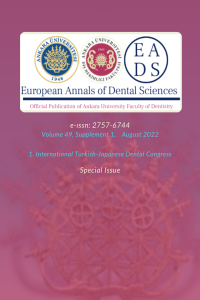Abstract
Project Number
PYO.DIS.1901.19.002
References
- Zhang Q, Chen H, Fan B, Fan W, Gutmann JL. Root and root canal morphology in maxillary second molar with fused root from a native Chinese population. J Endod. 2014;40(6):871-875.
- Ordinola‐Zapata R, Martins J, Bramante CM, Villas-Boas MH, Duarte MH, Versiani MA. Morphological evaluation of maxillary second molars with fused roots: a micro‐CT study. Int Endod J. 2017;50(12):1192-1200.
- Martins JN, Mata A, Marques D, Caramês J. Prevalence of root fusions and main root canal merging in human upper and lower molars: a cone-beam computed tomography in vivo study. J Endod. 2016;42(6):900-908.
- Kim Y, Lee S-J, Woo J. Morphology of maxillary first and second molars analyzed by cone-beam computed tomography in a Korean population: variations in the number of roots and canals and the incidence of fusion. J Endod. 2012;38(8):1063-1068.
- Marcano-Caldera M, Mejia-Cardona JL, Blanco-Uribe MP, Chaverra-Mesa EC, Rodrigues-Lezama D, Parra-Sanchez JH. Fused roots of maxillary molars: characterization and prevalence in a Latin American sub-population: a cone beam computed tomography study. Rest Dent Endod. 2019;44(2):1-12.
- Peikoff M, Christie W, Fogel H. The maxillary second molar: variations in the number of roots and canals. Int Endod J. 1996;29(6):365-369.
- Vertucci FJ. Root canal morphology and its relationship to endodontic procedures. Endod Topics. 2005;10(1):3-29.
- Gulabivala K, Aung TH, Alavi A, Ng YL. Root and canal morphology of Burmese mandibular molars. Int Endod J. 2001;34(5):359-370.
- Aydin H. Analysis of root and canal morphology of fused and separate rooted maxillary molar teeth in Turkish population. Nigerian J Clin Pract. 2021;24(3):435-442.
- Ordinola‐Zapata R, Bramante C, Versiani M, Moldauer BI, Topham G, Gutmann, JL, Abella F. Comparative accuracy of the Clearing Technique, CBCT and Micro‐CT methods in studying the mesial root canal configuration of mandibular first molars. Int Endod J. 2017;50(1):90-96.
Micro-CT Analysis of the Root Canal Configuration of Maxillary Second Molars with Fusion
Abstract
Purpose: The present study investigated the root canal configuration of maxillary second molars with root fusion using micro-computed tomography (micro-CT).
Materials & Methods: A total of 136 fused maxillary second molars were scanned with micro-computed tomography. Images were transferred to CTAn v.1.18.8 software (Bruker-microCT) to obtain three-dimensional models. The specimens were classified according to the fusion type. According to Vertucci, classification of the root canal configuration of fused roots was determined using CTVol v. 2.3.2.0 (Bruker-microCT) and DataViewer v.1.5.6 (Bruker-microCT) softwares. The specimens that could not be represented were also specified. The frequency of canal configuration according to the fusion type was calculated.
Results: For Type 1 fusion (n=40) and Type 2 fusion (n=22), the most common canal configuration for mesiobuccal (MB), distobuccal (DB) and palatal (P) canals was Type I. In type 3 fusion specimens (n = 21), DB and P canals were completely fused in 1 sample in accordance with Vertucci type IV, while in the remaining specimens, types II, I, V, VI and IV were observed in decreasing order in the MB canal. In type 4 fusion, MB and DB canals were completely fused in 4 of 21 specimens and showed Vertucci type VI, II, I and III configurations. In the remaining 17 samples, MB had Vertucci type I, II, IV, V, VI, VII configurations, while DB showed type I, V and III configurations. In 7 samples with type 5 fusion all canals displayed different configurations. In type 6 fusion, the canal configurations of 6 samples could not be classified. Type II, I, and V configurations were seen in 9 of the remaining 19 samples with a single canal.
Conclusion: Vertucci type I was the dominant canal configuration in the P and DB, however, MB showed much more diverse configurations either independently or when included in fusion.
Supporting Institution
Samsun Ondokuz Mayis University Research Fund
Project Number
PYO.DIS.1901.19.002
Thanks
This study was supported by the Samsun Ondokuz Mayis University Research Fund (Project No: PYO.DIS.1901.19.002). Authors deny any conflict of interest.
References
- Zhang Q, Chen H, Fan B, Fan W, Gutmann JL. Root and root canal morphology in maxillary second molar with fused root from a native Chinese population. J Endod. 2014;40(6):871-875.
- Ordinola‐Zapata R, Martins J, Bramante CM, Villas-Boas MH, Duarte MH, Versiani MA. Morphological evaluation of maxillary second molars with fused roots: a micro‐CT study. Int Endod J. 2017;50(12):1192-1200.
- Martins JN, Mata A, Marques D, Caramês J. Prevalence of root fusions and main root canal merging in human upper and lower molars: a cone-beam computed tomography in vivo study. J Endod. 2016;42(6):900-908.
- Kim Y, Lee S-J, Woo J. Morphology of maxillary first and second molars analyzed by cone-beam computed tomography in a Korean population: variations in the number of roots and canals and the incidence of fusion. J Endod. 2012;38(8):1063-1068.
- Marcano-Caldera M, Mejia-Cardona JL, Blanco-Uribe MP, Chaverra-Mesa EC, Rodrigues-Lezama D, Parra-Sanchez JH. Fused roots of maxillary molars: characterization and prevalence in a Latin American sub-population: a cone beam computed tomography study. Rest Dent Endod. 2019;44(2):1-12.
- Peikoff M, Christie W, Fogel H. The maxillary second molar: variations in the number of roots and canals. Int Endod J. 1996;29(6):365-369.
- Vertucci FJ. Root canal morphology and its relationship to endodontic procedures. Endod Topics. 2005;10(1):3-29.
- Gulabivala K, Aung TH, Alavi A, Ng YL. Root and canal morphology of Burmese mandibular molars. Int Endod J. 2001;34(5):359-370.
- Aydin H. Analysis of root and canal morphology of fused and separate rooted maxillary molar teeth in Turkish population. Nigerian J Clin Pract. 2021;24(3):435-442.
- Ordinola‐Zapata R, Bramante C, Versiani M, Moldauer BI, Topham G, Gutmann, JL, Abella F. Comparative accuracy of the Clearing Technique, CBCT and Micro‐CT methods in studying the mesial root canal configuration of mandibular first molars. Int Endod J. 2017;50(1):90-96.
Details
| Primary Language | English |
|---|---|
| Subjects | Dentistry |
| Journal Section | Conference Papers |
| Authors | |
| Project Number | PYO.DIS.1901.19.002 |
| Publication Date | August 31, 2022 |
| Submission Date | June 23, 2021 |
| Published in Issue | Year 2022 Volume: 49 Issue: Suppl 1 |

